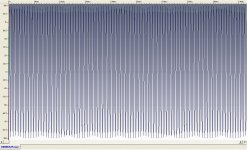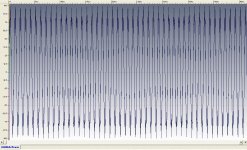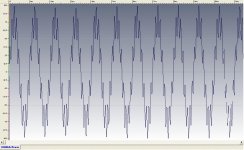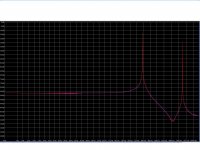Perseid meteor shower sound
Diversion. Listen to this:
Perseid Meteor Shower Sounds: Space Surveillance Radar Captures Celestial Audio (LISTEN)
Don't know how to pick up sound with a radar, but still cool.
vac
Diversion. Listen to this:
Perseid Meteor Shower Sounds: Space Surveillance Radar Captures Celestial Audio (LISTEN)
Don't know how to pick up sound with a radar, but still cool.
vac
Last edited:
@ Thorsten_L.,
even if it is known that each switch position is connected to a different DUT, it is still a double blind test if the switching person and the listener do not know what DUT it is.
It might need more trial to reach the same level of significance, but that is normally a minor problem.
@ SY,
in fact the comparison of coupling caps was the very first controlled test we did aroun ´84.
Two capacitiors with different dielectrica from different manufacturers 4.7µF/5% each, output impedance <100Ohms, input impedance 47k.
Single blind test, 5 trials, positive identification of the better capacitor was needed for a correct answer. (better as chosen during the preceding sighted listening test).
I got 5/5 (actual p=0.031), the subjective evaluation led to the impression that the difference was´ huge´ yet hard to detect in a blind test at first. After we got used to the procedure the difference was still ´huge´ even under test conditions.
even if it is known that each switch position is connected to a different DUT, it is still a double blind test if the switching person and the listener do not know what DUT it is.
It might need more trial to reach the same level of significance, but that is normally a minor problem.
@ SY,
in fact the comparison of coupling caps was the very first controlled test we did aroun ´84.
Two capacitiors with different dielectrica from different manufacturers 4.7µF/5% each, output impedance <100Ohms, input impedance 47k.
Single blind test, 5 trials, positive identification of the better capacitor was needed for a correct answer. (better as chosen during the preceding sighted listening test).
I got 5/5 (actual p=0.031), the subjective evaluation led to the impression that the difference was´ huge´ yet hard to detect in a blind test at first. After we got used to the procedure the difference was still ´huge´ even under test conditions.
Hi,
In our case the question we are asking is "which is better" (differences are taken as existing), so for our use the protocol is more suited.
Yes, this issue (unknown procedure, test-stress) together with expectation bias (pacebo/nocebo effect) combine to make getting "null results" quite easy, especially in the kind of challenges ABX proponents are want(on) to issue.
To me for example it is crucial that s much information is extracted with as few trials as possible, this reduces the needed attention span and stress (and cost). Equally it is VERY important to me that listeners are familiar with the system, the music and the process, yet that the identity of the change being evaluated is kept secret, so where there is no expectation there is no expectation bias and stress and unfamiliarity is minimised.
Of course, unlike some, I am not in the business of reliably producing null results in blind testing regardless if real differences are present or not. My game is in answering the question if a cheaper part can perform subjectively as well as an expensive one and which of those available are most suitable to my requirements, so my methods of course differ from those employed by the ABX Mafia.
Ciao T
even if it is known that each switch position is connected to a different DUT, it is still a double blind test if the switching person and the listener do not know what DUT it is.
It might need more trial to reach the same level of significance, but that is normally a minor problem.
In our case the question we are asking is "which is better" (differences are taken as existing), so for our use the protocol is more suited.
I got 5/5 (actual p=0.031), the subjective evaluation led to the impression that the difference was´ huge´ yet hard to detect in a blind test at first. After we got used to the procedure the difference was still ´huge´ even under test conditions.
Yes, this issue (unknown procedure, test-stress) together with expectation bias (pacebo/nocebo effect) combine to make getting "null results" quite easy, especially in the kind of challenges ABX proponents are want(on) to issue.
To me for example it is crucial that s much information is extracted with as few trials as possible, this reduces the needed attention span and stress (and cost). Equally it is VERY important to me that listeners are familiar with the system, the music and the process, yet that the identity of the change being evaluated is kept secret, so where there is no expectation there is no expectation bias and stress and unfamiliarity is minimised.
Of course, unlike some, I am not in the business of reliably producing null results in blind testing regardless if real differences are present or not. My game is in answering the question if a cheaper part can perform subjectively as well as an expensive one and which of those available are most suitable to my requirements, so my methods of course differ from those employed by the ABX Mafia.
Ciao T
Ok, I just started skimming that thread, and message #34 saysEveryone, and anyone who wants to know about the BLOWTORCH principles, limitations and costs, just look at the first 100 pages of the previous Blowtorch thread.
This has me baffled - the definition of 'servo' involves feedback. So, how can the Blowtorch be "no feedback" if it includes a servo?Just chatted with JC. Yes, the case is indeed milled from a solid billet of aluminum. Pantograph lettering. $3000 manufacturer's cost for the case alone. All FET, no feedback, servoed. First stage is 4 quadrant comp diff, second is folded cascode using MOSFETs run at high current. Servo with roughly 1 sec time constant.
Perhaps the real meaning behind 'no feedback' was actually 'no feedback to speak of within the audio band' ?
Ok, I just started skimming that thread, and message #34 says
This has me baffled - the definition of 'servo' involves feedback. So, how can the Blowtorch be "no feedback" if it includes a servo?
The servo only corrects the DC errors, the ac gain is unaffected by this. So John is correct in what he says about his design. the servo is to keep the output node at 0 volts.
Yes- "no feedback" in the audiophile sense (I'm sure there are also followers in there, which in a technical sense is absolutely feedback, but there's no explicit out-to-in loop).
So the servo has a brickwall filter? In a no-signal-cap, DC servo design the LF point is set by the (capacitors in the) servo rather than the (capacitors in the) main amp circuit. Unless done very carefully, this could be worse. Getting a servo right is much harder than getting a CR rolloff right.
Yes, a servo means feedback at DC and subsonic at least, tailing off into the audio band. A 1 sec servo time constant means (other things being equal) an LF point of 0.16Hz so feedback is 40dB down at 16Hz. Very small, but not negligible?
Yes, a servo means feedback at DC and subsonic at least, tailing off into the audio band. A 1 sec servo time constant means (other things being equal) an LF point of 0.16Hz so feedback is 40dB down at 16Hz. Very small, but not negligible?
Yes, a servo means feedback at DC and subsonic at least, tailing off into the audio band. A 1 sec servo time constant means (other things being equal) an LF point of 0.16Hz so feedback is 40dB down at 16Hz. Very small, but not negligible?
Well, what happens to the gain at 16Hz when the servo is disconnected?
Hi,
Sorry, the test results are considered intellectual property by AMR, so I am not at liberty to discuss.
However you can find the results indirectly in the details and reviews published on AMR Products.
Ciao T
Would you care to share your findings about different capacitors?
Sorry, the test results are considered intellectual property by AMR, so I am not at liberty to discuss.
However you can find the results indirectly in the details and reviews published on AMR Products.
Ciao T
Well, Thorsen, at least you are FINDING differences in caps. I would certainly hope so. I would be afraid to discuss caps here the way Charles Hansen and I do, over the phone. In fact, it would tick off Charles if I did, as we have our 'trade secrets' too! So much for 'all caps sound the same'. That is for double blind tests to show, not our ears.
Last edited:
This is nonsense. Of course, the servo operates below 1 Hz, AND the circuit operates perfectly fine WITHOUT the servo, except that there will be a little inherent offset due to the slight factory generated errors in the selected high current 2SK389-2SJ109 combination. The servo is deliberately 'detuned' to have the minimum effect possible on the audio path and have to 'work' even to obtain 0 offset, usually having about 2V or so at its output, for perhaps, correcting 10mV offset, total, or less.
I am not much of a believer in adding more radical efforts to reduce the servo's contribution, as it increases part count, and perhaps might add phase shift to increase potential instability. Servo insertion is at the least obtrusive point, being in the output devices, rather than at the input. The input devices settle down to their own inherent offset and the servo corrects for it at a later stage. The environment is 24 hour class A operation, where the significant power dissipating devices are thermally coupled through Alumunum Oxide insulators directly to the top of the CASE of the Blowtorch, the enclosure, then acting as a large, high thermal mass heatsink, along with its inherent RF, IF, and even somewhat LF shielding properties, keeping it at constant thermal temperature for an indefinite period of time, presuming the room, itself is not changing too much in temperature. Also, of course, the lack of seams or vent holes, keeps the dust out of the inside of the case. Unfortunately, we did NOT seal the case completely and then use an inert gas to keep the interior completely corrosion free. It would have been a good idea though, but impractical.
I am not much of a believer in adding more radical efforts to reduce the servo's contribution, as it increases part count, and perhaps might add phase shift to increase potential instability. Servo insertion is at the least obtrusive point, being in the output devices, rather than at the input. The input devices settle down to their own inherent offset and the servo corrects for it at a later stage. The environment is 24 hour class A operation, where the significant power dissipating devices are thermally coupled through Alumunum Oxide insulators directly to the top of the CASE of the Blowtorch, the enclosure, then acting as a large, high thermal mass heatsink, along with its inherent RF, IF, and even somewhat LF shielding properties, keeping it at constant thermal temperature for an indefinite period of time, presuming the room, itself is not changing too much in temperature. Also, of course, the lack of seams or vent holes, keeps the dust out of the inside of the case. Unfortunately, we did NOT seal the case completely and then use an inert gas to keep the interior completely corrosion free. It would have been a good idea though, but impractical.
In general, I think that servos are interesting and should be more often discussed. There are many 'bad' servos out there, that most probably change the sound of the audio system in a serious way. For example, the servos that I design in the Parasound products cannot be as 'remote' as the servos in the Blowtorch, because I cannot depend on long warmup and continuous operation in my power amps. This means that the servos have to respond quicker, and thereby lies a potential problem. However, the power amps have lots of feedback, anyway, so a tiny addition will not change things much, but I am always wary, and I bet that sometimes it effects ultimate performance, especially when my best Parasound designs have to go against competing designs from Ayre, because they don't use servos.
So any hardy souls venture to guess about this sound?
Seems like a mono recording, 2 tones ~ 1kHz and ~8kHz. I guess there are some more peaks above 20kHz (I bet that there is one more main tone).
What worries me is that I can’t hear the amplitude modulation (useless ears) 😡
Regards
George
Attachments
- Status
- Not open for further replies.
- Home
- Member Areas
- The Lounge
- John Curl's Blowtorch preamplifier part II



